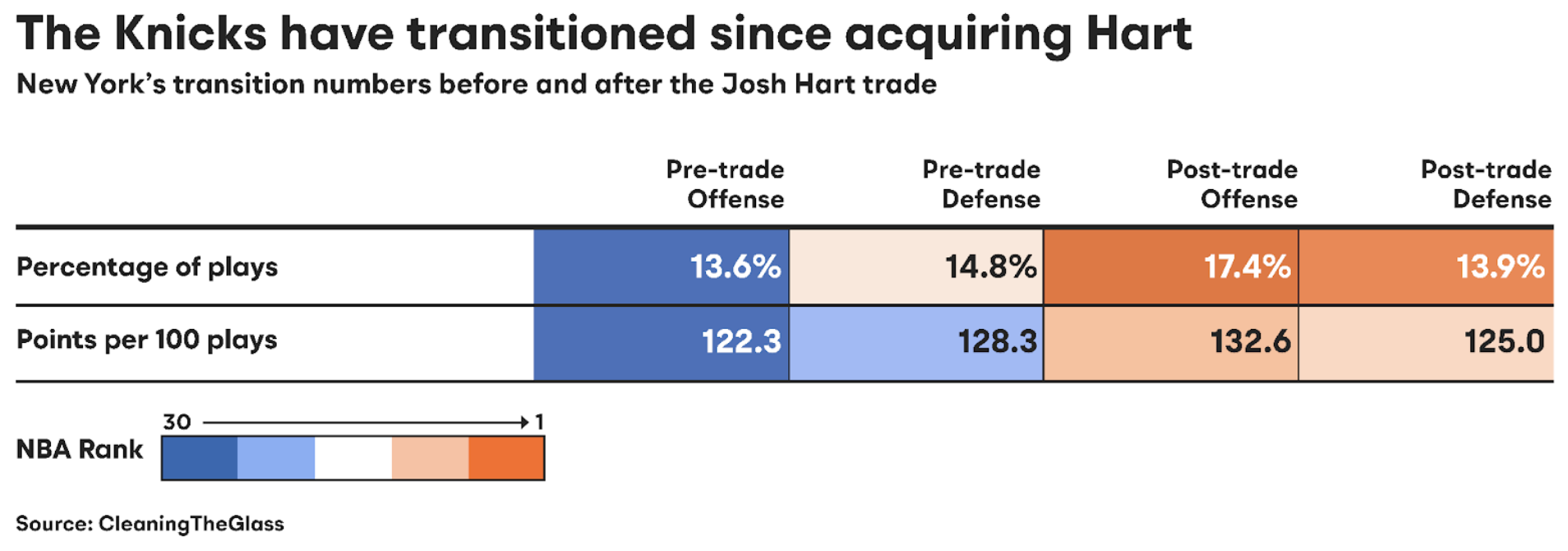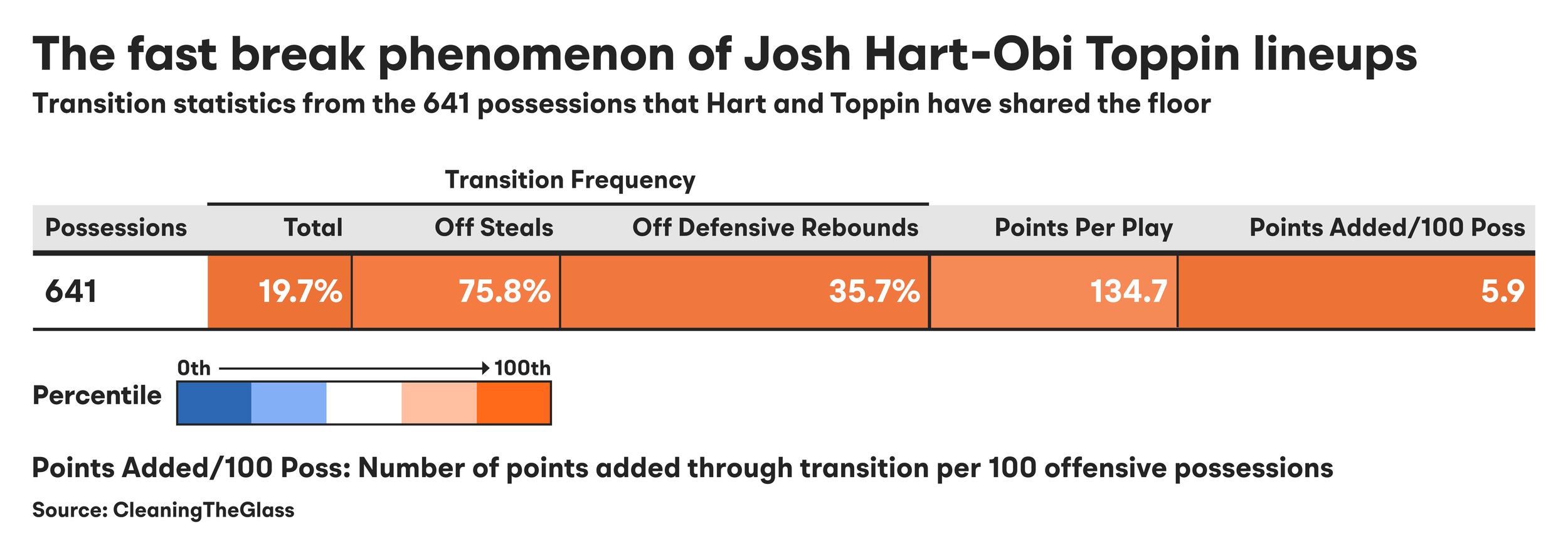Josh Hart’s leading a transition in New York
The Knicks have been a different team since Josh Hart’s arrival at the trade deadline, and his ability to get the Knicks moving in transition has been one of the biggest reasons.
As the play-in is underway, Knicks fans are gearing up for the playoffs on the heels of a triumphant second half of the season, where New York went 28-16 after the turn of the calendar year. A major piece of that run was the addition of swingman Josh Hart — a player the Knicks acquired hours before the Feb. 9 trade deadline. The acquisition has been great for New York, with Hart averaging 10.3 points and 6.9 rebounds in 30.2 minutes per contest off the bench. While he has generated solid box-score production for the Knicks, Josh Hart sparked upheaval in another sense: the fast break.
New York spent most of the season as a well-below-average team in transition; they were out-paced by their opponents and inefficient on both ends of the floor. In the 25 games since the trade, the Knicks have run the break at a top-five clip, as they rank second in offensive transition frequency (the percentage of offensive plays that begin in transition). Not only have they just pushed the pace more offensively, but New York has also remarkably improved their output in transition — scoring 10.3 more points per 100 offensive transition plays. On the other end, the Knicks have become one of the league’s best at setting up their defense, where they rank fourth in defensive transition frequency since the acquisition.
In just 716 minutes that Josh Hart has been on the floor, New York has been (unsurprisingly) even better on the break. With No. 3 in the game, the Knicks sit atop the league in both offensive and defensive transition frequency at 18.7% and 12.8%, respectively. While pushing the pace at a rate one-and-a-half times that of their opponent is impressive in and of itself, New York has also outscored their opposition by 15 points per 100 transition plays. On average, the Knicks score 6 more points than their opponents through transition in the 30.2 minutes that Hart plays—and in a season where New York has lost 22 games in the clutch, those are a valuable six points to have nightly.
Success in transition is not exclusive to Josh Hart or the post-trade New York Knicks. The fast break is the most efficient play in basketball, which is why out-pacing the opponent is of such importance. An average NBA play (anything that leads to a shot attempt, turnover, or free throws) generates about 1.03 points. Transition plays, on the other hand, produce a staggering 1.27 points per play. Even the NBA’s worst transition offense, the Dallas Mavericks, score 1.19 points per fast break play, 14.0 points more per 100 plays than the league’s best half-court offense, the… Dallas Mavericks. The effectual nature of transition basketball demonstrates the value in being able to start the break.
So, why does Josh Hart generate so many transition plays?
Since arriving in The Big Apple, Josh Hart has been a pest defensively, often nabbing steals in the process — most of which lead to transition plays. But, above all else, Hart is probably most notable for his ability to rebound. Standing at 6-foot-5, he is collecting an impressive 7.8 boards per game for the season. Defensive rebounds are a vehicle for starting the break, as the rebounder has the ability to drive against a scrambling defense; that is the advantage to ball-handlers (like Hart) grabbing the miss, as the ensuing offensive attack does not have to wait for an outlet pass to be thrown. When Hart rebounds the ball, he is able to push the pace.
One thing is for certain: Josh Hart moves with expediency following a defensive rebound. However, his course of action to start the break varies play by play. Many of the chronicled post-rebound transition plays begin by an aggregate of two actions — deep outlet passes and Hart taking it coast to coast himself. He is well-suited for both, as he has shown the ability to swish and dish given the opportunity. Since the trade, Hart has posted notable figures in both scoring and passing metrics; he is scoring 1.38 points per shot attempt and has marked a 1.11 assist:usage ratio (assist percentage divided by usage rate), good for 98th and 96th percentile, respectively.
When driving to the rim — the NBA’s primary action on the fast break — Hart has been exceptional in New York. While taking over half of his shots at the cup (51%), Hart has made an efficient 75% of his finishes. He has been successful in drawing fouls as well; the swingman has gone to the line following 14.5% of his shot attempts. All three figures (rim frequency, rim accuracy, and foul-drawing frequency) place Hart in the 90th percentile for wings, demonstrating his ability to drive to the basket. That proficiency in getting to the rim is a fast break necessity that the league’s individual transition forces (Giannis Antetokounmpo, LeBron James) possess.
Hart is not the only Knick reaping the benefits of a high volume of plays in transition. New York’s leading scorers have found easy buckets on the break, a sigh of relief from the often isolation-heavy scoring they are tasked with. The Knicks’ five core bucket-getters (Julius Randle, Jalen Brunson, RJ Barrett, Immanuel Quickley, and Quentin Grimes) all rank top-70 in transition points. They have generated easier looks when pushing the pace, and their shooting efficiency reflects that — the players’ effective field goal percentage in transition is, on average, 7.3% greater than their season average.
Yet, nobody has made the most of more transition opportunities like Obi Toppin has. The former top-five pick loves to get out and run the floor — most cynically reflected by his mere 13% defensive rebound percentage. Obi’s average speed on offense (4.83 miles per hour) ranks third amongst bigs that have played 750 minutes this season. When he has gotten the ball on the break, Toppin has found success, scoring on 58.8% of his logged transition possessions. So, how has the former Dayton Flyer fared with an uptick in transition plays? Before the Hart trade, Toppin shot a measly 60.3% on 1.7 attempts per game. Since, he has finished a staggering 86.0% of his 2.3 attempts a game at the cup. When Hart and Toppin have shared the floor together, the numbers have reflected their match made in heaven.
Lineups including the pairing have posted a league-best offensive rating of 125.0, and it’s hard not to see their transition offense at the heart of that success. They have pushed the pace in transition on nearly one-fifth of their offensive plays (for context, the NBA’s most active transition offense, the Memphis Grizzlies, boasts a transition percentage of 17.9%). Despite their high volume on the break, Hart-Toppin lineups have also thrived on a per possession basis, with such lineups scoring 134.7 points per 100 transition plays, a mark that would rank second in the league.
Cavaliers star Donovan Mitchell — the Knicks’ upcoming first-round opponent — noted New York’s fast pace with Hart and Toppin on the court, saying, “[Quickley], Obi, Hart, Jalen [Brunson], Hartenstein. They’re running, they’re flying.” While Toppin’s minutes are sure to shrink come playoff time (pending Julius Randle’s health), he serves as a paragon for Hart’s impact in generating easy looks in transition, one of the many reasons why the Knicks hold the league’s best offense since his arrival. And when the game starts to slow in the playoffs (especially against the NBA’s slowest team, the Cleveland Cavaliers) finding those extra few easy buckets that Hart creates may be the difference between a flight to Cancun or Milwaukee.






